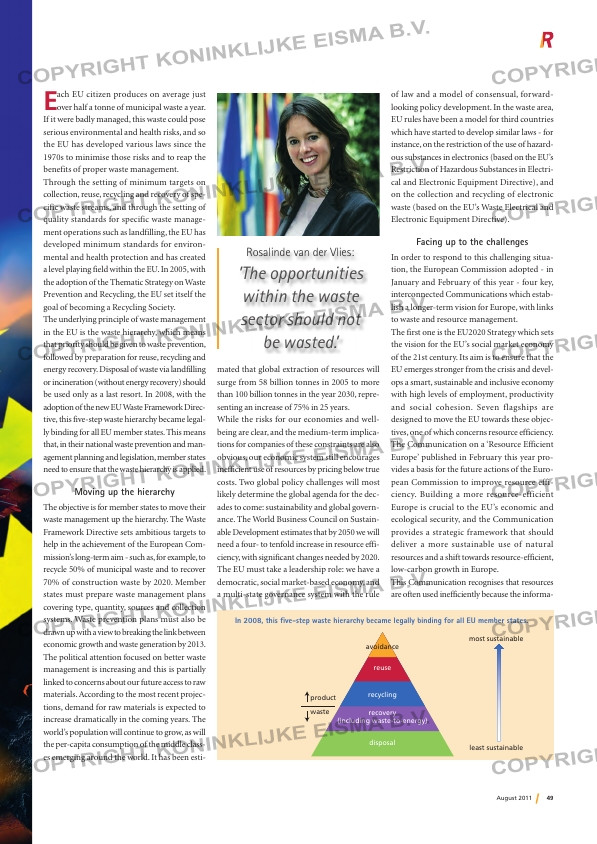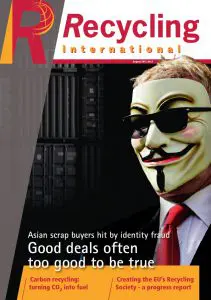Page 49 from: August 2011

49August 2011
Each EU citizen produces on average just over half a tonne of municipal waste a year.
If it were badly managed, this waste could pose
serious environmental and health risks, and so
the EU has developed various laws since the
1970s to minimise those risks and to reap the
benefits of proper waste management.
Through the setting of minimum targets on
collection, reuse, recycling and recovery of spe-
cific waste streams, and through the setting of
quality standards for specific waste manage-
ment operations such as landfilling, the EU has
developed minimum standards for environ-
mental and health protection and has created
a level playing field within the EU. In 2005, with
the adoption of the Thematic Strategy on Waste
Prevention and Recycling, the EU set itself the
goal of becoming a Recycling Society.
The underlying principle of waste management
in the EU is the waste hierarchy, which means
that priority should be given to waste prevention,
followed by preparation for reuse, recycling and
energy recovery. Disposal of waste via landfilling
or incineration (without energy recovery) should
be used only as a last resort. In 2008, with the
adoption of the new EU Waste Framework Direc-
tive, this five-step waste hierarchy became legal-
ly binding for all EU member states. This means
that, in their national waste prevention and man-
agement planning and legislation, member states
need to ensure that the waste hierarchy is applied.
Moving up the hierarchy
The objective is for member states to move their
waste management up the hierarchy. The Waste
Framework Directive sets ambitious targets to
help in the achievement of the European Com-
mission’s long-term aim – such as, for example, to
recycle 50% of municipal waste and to recover
70% of construction waste by 2020. Member
states must prepare waste management plans
covering type, quantity, sources and collection
systems. Waste prevention plans must also be
drawn up with a view to breaking the link between
economic growth and waste generation by 2013.
The political attention focused on better waste
management is increasing and this is partially
linked to concerns about our future access to raw
materials. According to the most recent projec-
tions, demand for raw materials is expected to
increase dramatically in the coming years. The
world’s population will continue to grow, as will
the per-capita consumption of the middle class-
es emerging around the world. It has been esti-
mated that global extraction of resources will
surge from 58 billion tonnes in 2005 to more
than 100 billion tonnes in the year 2030, repre-
senting an increase of 75% in 25 years.
While the risks for our economies and well-
being are clear, and the medium-term implica-
tions for companies of these constraints are also
obvious, our economic system still encourages
inefficient use of resources by pricing below true
costs. Two global policy challenges will most
likely determine the global agenda for the dec-
ades to come: sustainability and global govern-
ance. The World Business Council on Sustain-
able Development estimates that by 2050 we will
need a four- to tenfold increase in resource effi-
ciency, with significant changes needed by 2020.
The EU must take a leadership role: we have a
democratic, social market-based economy, and
a multi-state governance system with the rule
Rosalinde van der Vlies:
’The opportunities
within the waste
sector should not
be wasted.’
of law and a model of consensual, forward-
looking policy development. In the waste area,
EU rules have been a model for third countries
which have started to develop similar laws – for
instance, on the restriction of the use of hazard-
ous substances in electronics (based on the EU’s
Restriction of Hazardous Substances in Electri-
cal and Electronic Equipment Directive), and
on the collection and recycling of electronic
waste (based on the EU’s Waste Electrical and
Electronic Equipment Directive).
Facing up to the challenges
In order to respond to this challenging situa-
tion, the European Commission adopted – in
January and February of this year – four key,
interconnected Communications which estab-
lish a longer-term vision for Europe, with links
to waste and resource management.
The first one is the EU2020 Strategy which sets
the vision for the EU’s social market economy
of the 21st century. Its aim is to ensure that the
EU emerges stronger from the crisis and devel-
ops a smart, sustainable and inclusive economy
with high levels of employment, productivity
and social cohesion. Seven flagships are
designed to move the EU towards these objec-
tives, one of which concerns resource efficiency.
The Communication on a ‘Resource Efficient
Europe’ published in February this year pro-
vides a basis for the future actions of the Euro-
pean Commission to improve resource effi-
ciency. Building a more resource-efficient
Europe is crucial to the EU’s economic and
ecological security, and the Communication
provides a strategic framework that should
deliver a more sustainable use of natural
resources and a shift towards resource-efficient,
low-carbon growth in Europe.
This Communication recognises that resources
are often used inefficiently because the informa-
In 2008, this five-step waste hierarchy became legally binding for all EU member states.
most sustainable
product
waste
avoidance
reuse
recycling
recovery
(including waste-to-energy)
disposal
least sustainable
p048_EU Waste.indd 49 08-08-11 14:31



